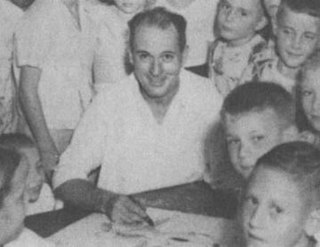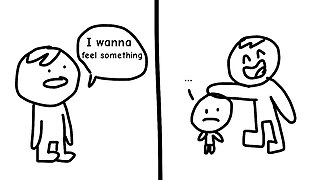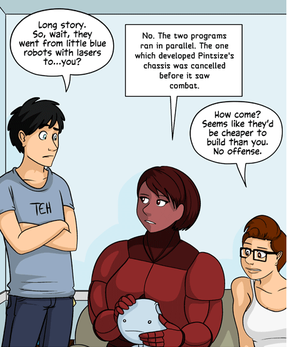A comic strip is a sequence of cartoons, arranged in interrelated panels to display brief humor or form a narrative, often serialized, with text in balloons and captions. Traditionally, throughout the 20th and into the 21st century, these have been published in newspapers and magazines, with daily horizontal strips printed in black-and-white in newspapers, while Sunday papers offered longer sequences in special color comics sections. With the advent of the internet, online comic strips began to appear as webcomics.

Charles Alfred "Al" Taliaferro, was an American Disney comics artist who produced Disney comic strips for King Features Syndicate. Taliaferro is best known for his work on the Donald Duck comic strip. Many of his strips were written by Bob Karp.

Webcomics are comics published on the internet, such as on a website or a mobile app. While many webcomics are published exclusively online, others are also published in magazines, newspapers, or comic books.

Achewood is a webcomic created by Chris Onstad in 2001. It portrays the lives of a group of anthropomorphic stuffed toys, robots, and pets. Many of the characters live together in the home of their owner, Chris, at the fictional address of 62 Achewood Court. The events of the strip mostly take place in and around the house, as well as around the town of Achewood, a fictional suburb.

Fetus-X was a weekly romantic horror comic written and drawn by Eric Millikin and Casey Sorrow. Millikin is an American artist and former human anatomy lab embalmer and dissectionist. Sorrow is an internationally known American illustrator and printmaker.

Questionable Content is a slice-of-life webcomic written and illustrated by Jeph Jacques. It was launched in August 2003 and reached its 5,000th comic in March 2023. The plot originally centered on Marten Reed, an indie rock fan; his anthropomorphized personal computer Pintsize; and his roommate, Faye Whitaker. However, over time Jacques has added a supporting cast of characters that includes employees of the local coffee shop, neighbors, and androids. QC's storytelling style combines romantic melodrama, situational comedy, and sexual humor, while considering questions of relationships, sexuality, dealing with emotional trauma, and artificial intelligence and futurism.

King Features Syndicate, Inc. is an American content distribution and animation studio, consumer product licensing and print syndication company owned by Hearst Communications that distributes about 150 comic strips, newspaper columns, editorial cartoons, puzzles, and games to nearly 5,000 newspapers worldwide. King Features Syndicate also produces intellectual properties, develops new content and franchises, like The Cuphead Show!, which it produced with Netflix, and licenses its classic characters and properties.

VG Cats is a webcomic written and drawn by Canadian cartoonist Scott Ramsoomair. Published on its own website, it follows the adventures of a pair of anthropomorphic cats, who both have an interest in video games, and often play the roles of characters in popular games that are parodied in the strip.

Brad Guigar is an American cartoonist who is best known for his daily webcomic Greystone Inn and its sequel Evil Inc.
Sheldon is a comedy webcomic created by Dave Kellett. It centers on the odd family unit of 10-year-old Sheldon, his grandfather guardian and his talking duck, Arthur. Much humour is character-based, often joking at traits such as Sheldon's geekiness, Gramp's old age or Arthur's over-inflated ego. Kellett's other webcomic, Drive, had appeared on the Sheldon site each Saturday, before moving to a site of its own.

David M Willis is an American web cartoonist currently living in Columbus, Ohio. He is best known for his interconnected series of webcomics Roomies!, It's Walky!, Shortpacked!, and Dumbing of Age. Willis is also known online for his chatrooms and forums including "ItsWalky". KUTV in Salt Lake City calls him a satirist who is "a little bit edgy."

Frank and Ernest is an American comic strip created and illustrated by Bob Thaves and later Tom Thaves. It debuted on November 6, 1972, and has since been published daily in over 1,200 newspapers. The humor of the comic is based almost exclusively on wordplay and puns.
Maura is a female given name primarily used in English, Spanish, Italian, Greek, Scots Gaelic, and Irish. It appears as the feminine form of the Roman given name Maurus and as an Anglicisation of Máire, the Irish form of Mary.
Sluggy Freelance is a long-running webcomic written and drawn by Pete Abrams. Starting in 1997, it is one of the oldest successful webcomics, and as of 2012 had hundreds of thousands of readers. Abrams was one of the first comic artists successful enough to make a living from a webcomic.
The business of webcomics involves creators earning a living through their webcomic, often using a variety of revenue channels. Those channels may include selling merchandise such as t-shirts, jackets, sweatpants, hats, pins, stickers, and toys, based on their work. Some also choose to sell print versions or compilations of their webcomics. Many webcomic creators make use of online advertisements on their websites, and possibly even product placement deals with larger companies. Crowdfunding through websites such as Kickstarter and Patreon are also popular choices for sources of potential income.
Notable events of the late 1990s in webcomics.
Brian Gordon is an American cartoonist, and creator of the webcomics Fowl Language, Frankie Fearless, and Chuck & Beans.
Donald Duck is an American comic strip by the Walt Disney Company starring Donald Duck, distributed by King Features Syndicate. The first daily Donald Duck strip debuted in American newspapers on February 7, 1938. On December 10, 1939, the strip expanded to a Sunday page as well. Writer Bob Karp and artist Al Taliaferro worked together on the strip for more than 30 years. The strip ended in May 1995.











